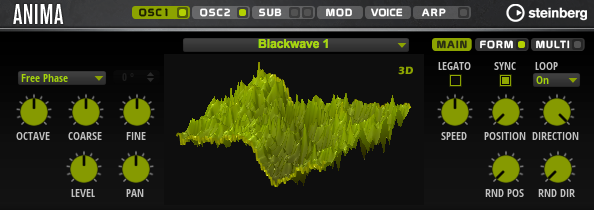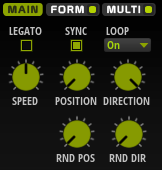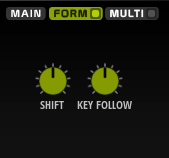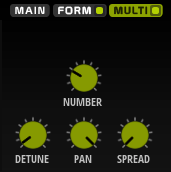Oscillator Pages
The Osc 1 and Osc 2 pages contain the settings for the two main oscillators.

-
To show the settings for oscillator 1 or oscillator 2, click the corresponding button.
-
To activate/deactivate an oscillator, click the On/Off button on the right of the corresponding page button.
- Select Wavetable
-
This pop-up menu allows you to select one of the included wavetables for the wavetable oscillator.
- Show 3D Wavetable Map/2D Wave
-
Toggles between displaying a single cycle of the current waveform and a topographic map of the entire wavetable.
- Retrigger Mode
-
-
If Free Phase is selected, the behavior of analog synthesizers is emulated. The oscillator is running freely and continuously.
-
If Random Phase is selected, the start phase is randomly set to a different value each time that you trigger a note. In contrast to Free Phase, there is no continuity in the phase of the waveform.
-
If Fixed Phase is selected, the oscillator runs with a fixed start phase that can be specified between 0 and 360 degrees.
-
- Octave
-
Adjusts the pitch in octave steps.
- Coarse
-
Adjusts the pitch in semitone steps.
- Fine
-
Adjusts the pitch in cent steps. This allows you to fine-tune the oscillator sound.
- Level
-
Adjusts the output level of the oscillator.
- Pan
-
Adjusts the position of the oscillator in the stereo panorama. At a setting of -100 %, the sound is panned hard left, and at +100 %, it is panned hard right.
Main Tab

- Legato
-
If Legato is deactivated, each note starts playback from the position cursor.
If Legato is activated, the first note starts playback from the position cursor, and any following notes start from the current playback position for as long as the first note is held.
- Sync to Host
-
Allows you to sync the wavetable to the beats and measures of your host application.
- Loop Mode
-
-
Off: If Playback Direction is set to a positive value, the wavetable plays from the position cursor to the end.
If Playback Direction is set to a negative value, the wavetable plays from the position cursor to the start.
-
On: Depending on the Playback Direction setting, the wavetable plays forward or backward in a loop.
-
Alt: The wavetable plays in an alternate loop, that is, the loop is alternately played forward and backward. The first direction depends on the Playback Direction setting.
-
- Speed
-
Determines the rate at which the envelope plays through the wavetables. At +100 %, the envelope plays back at its original speed. A value of +50 % corresponds to half the original speed, and +200 % to twice the original speed, for example.
This parameter is unipolar.
- Position
-
Determines where the envelope starts.
- Playback Direction
-
Allows you to set the playback speed in smaller increments. Furthermore, this parameter determines the playback direction.
-
If you enter negative values, you reverse playback, that is, the playback position moves backward through the wavetable.
-
- Random Position
-
Adds a random value to the current position when you play a note.
For example, if you want the position to vary between 25.0 % and 75.0 %, set Position to 25.0 % and Random Position to 50.0 %.
- Random Direction
-
Adds a negative or positive random value to the current direction when you play a note.
For example, if you want the direction to vary between -100 % and +100 %, set Direction to 0.0 % and Random Direction to 100.0 %. If you want the direction to vary within the full positive range, set Direction to 50 % and Random Direction to 50 %, for example.
Form Tab

Formants are harmonics within the spectrum of a note which are pronounced and help to define the character of an instrument. The positions of the formants in the spectrum mainly depend on the construction of an instrument, such as the body of a guitar, the form of the vocal tract in a human body, the filter settings for electronic instruments, etc. These conditions lead to specific frequency ranges that are emphasized regardless of the pitch of the note. Playing back samples or wavetables with a different pitch than the original is usually done by increasing or decreasing the playback speed. This leads to the well-known monster or Mickey Mouse effect, because all harmonics are also affected, that is, the characteristic formants are shifted. To avoid this, you can activate the Formant option.
- On/Off
-
Activates/Deactivates the formant settings.
- Formant
-
Allows you to shift the formants of the entire wavetable by a fixed value.
- Key Follow
-
Allows you to shift the formants depending on the played note.
-
A value of 100 % means that the formant frequency moves with the played note.
-
A value of 0 % means that the formants kept the same for all notes.
You can invert the behavior of the formant shift by setting Key Follow to negative values.
-
Multi Tab

The multi-oscillator function allows you to trigger multiple voices simultaneously with each note that you play. If you activate Multi, the following parameters become available:
-
Number determines the number of oscillators that play back simultaneously. You can also set fractions of numbers. For example, with a setting of 2.5, you hear two oscillators at full level and a third one at half level.
-
Detune detunes the oscillators.
-
Pan narrows or widens the stereo panorama. With a setting of 0 %, you create a mono signal and with 100 %, you create a stereo signal.
-
Spread distributes the oscillators so that each oscillator plays from a different position in the wavetable.